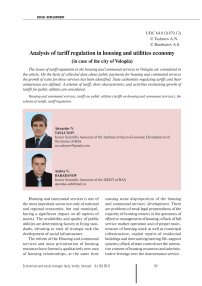Analysis of tariff regulation in housing and utilities economy (in case of the city of Vologda)
Автор: Taslunov Alexarder Nikolaevich, Barabanov Andrey Sergeevich
Журнал: Economic and Social Changes: Facts, Trends, Forecast @volnc-esc-en
Рубрика: Social development
Статья в выпуске: 6 (18) т.4, 2011 года.
Бесплатный доступ
The issues of tariff regulation in the housing and communal services in Vologda are considered in the article. On the basis of collected data about public payments for housing and communal services the growth of rates for these services has been identified. State authorities regulating tariffs and their competence are defined. A scheme of tariff, their characteristics and activities restraining growth of tariffs for public utilities are considered.
Housing and communal services, tariffs on public utilities (tariffs on housing and communal services), the scheme of tariffs, tariff regulation
Короткий адрес: https://sciup.org/147223315
IDR: 147223315 | УДК: 64.012(470.12)
Текст научной статьи Analysis of tariff regulation in housing and utilities economy (in case of the city of Vologda)
Housing and communal services is one of the most important sector not only of national and regional economies, but and municipal, having a significant impact on all aspects of society. The availability and quality of public utilities are determining factors in living standards, elevating to rank of strategic task the development of social infrastructure.
The reform of the Housing and communal services and mass privatization of housing resources have formed a qualitatively new area of housing relationships, at the same time causing some disproportion of the housing and communal services’ development. There are problems of weak legal preparedness of the majority of housing owners in the questions of effective management of housing; of lack of full service market operation and of proper maintenance of housing stock as well as municipal infrastructure, capital repairs of residential buildings and internal engineering life-support systems; of lack of state control over the normative content of housing resources and administrative leverage over the maintenance service.
Тable 1. The participants of the analysis of tariffs on housing and communal services in Vologda
|
№ |
Address |
Management form* |
Organization’s name |
Part of the city |
|
1. |
29, Udarnikov St. |
Management company (private property) |
“Visis” Ltd. |
Central |
|
2. |
65, Kozlyonskaya St. |
Management company (Municipal) |
Municipal autonomous organization “Housing Authority of Vologda”, station number 2 |
Central |
|
3. |
5, Pervomayskaya St. |
Management company (Municipal) |
Municipal autonomous organization “Housing Authority of Vologda”, station number 2 |
Central |
|
4. |
18, Dalnaya St. |
homeowners association |
Homeowners association “Dalnaya 18” |
Riverside |
|
5. |
18, Samoylo St. |
Management company (private property) |
OJSC“Fryazinovo” |
Riverside |
|
6. |
22а, Dalnaya St. |
Management company (Municipal)) |
Municipal autonomous organization “Housing Authority of Vologda”, station number 2 |
Riverside |
|
7. |
77, Leningradskaya St. |
Housing and building company |
HBC “Risk” |
West |
|
8. |
8, Goncharnaya St. |
Housing cooperative |
Housing cooperative “MGC” |
West |
|
9. |
26, Petrozavodskaya St. |
Management company (private property) |
Management company “ RES-12+” Ltd. |
East |
|
10. |
10, Tekstilshikov St. |
Management company (private property) |
Management company “RES-12” Ltd. |
East |
|
* The main forms of managing the apartment building are homeowners association, management companies and direct management of an apartment house (Art. 135, 162, 164 Housing Code of RF). Management of apartment buildings can also carry out housing and housing cooperatives, which are special kinds of consumer cooperatives (Art. 110 Housing Code of RF). |
||||
A special imbalance in the development of housing and communal services can be seen in the pricing and tariff policy for the services of natural monopolies, on which depends the possibility of normal operation and development of enterprises communal complex. The procedure for establishing and forming tariffs for enterprises of this complex affects the interests both of the companies (in terms of the formation of the financial results of economic activity) and population (in terms of availability and opportunity to pay this type of service).
Therefore, the participants of the system of tariff regulation are interested in ensuring consistency of interests and in objectivity and transparency of the tariff regulation. Increased attention to the issues of tariffs for the services of enterprises of municipal housing and communal complex causes high monopolization of this sphere of economic activity that generates and justifies the need for analysis of the tariff regulation of this type of enterprises. Analysis of tariff regulation was based on the information about the payment for housing and com- munal services by the population in Vologda. The account-receipts of the housing owners of ten blocks of flats (different on management form and territorial location) were used as the materials (tab. 1).
Based on collected data the structure of payments for utility services1 was calculated in order to prove the influence of distinct tariffs for a total cost of services. The most expensive service is heating – 34% of the amount of utility payments, there are housing maintenance and hot water supply on the second and third places – 18 and 14%, respectively (tab. 2) . This is broadly in line with the All-Russian tendencies.
Almost 78% fall on utilities and 22% on housing services in the structure of the total payment for utility services in Vologda (in comparison with Russia as a whole – 84 and 16% respectively [10]).
Table 2. The structure of payments for utility services in Vologda, calculated for the apartments of 54 sq.m and a family of three
|
Type of public utilities |
2006 |
2007 |
2008 |
2009 |
2010 |
Change for 2010 – 2006 |
|
In all |
100.0 |
100.0 |
100.0 |
100.0 |
100.0 |
х |
|
Heating |
34.8 |
34.0 |
32.6 |
33.5 |
34.2 |
-0.6 |
|
Maintenance |
22.2 |
18.2 |
20.6 |
19.8 |
17.7 |
-4.5 |
|
Hot water |
14.1 |
13.8 |
13.2 |
13.5 |
13.8 |
-0.3 |
|
Electricity |
11.8 |
10.9 |
10.5 |
9.6 |
10.7 |
-1.1 |
|
Cold water |
6.8 |
7.2 |
7.6 |
8.7 |
8.6 |
1.8 |
|
Sewerage |
4.6 |
5.1 |
4.9 |
6.6 |
6.3 |
1.7 |
|
Capital repairs |
2.3 |
6.3 |
6.0 |
4.9 |
4.4 |
2.1 |
|
Gas |
1.9 |
2.0 |
2.4 |
2.0 |
2.4 |
0.5 |
|
Removal of domestic waste |
1.5 |
2.5 |
2.2 |
1.4 |
1.9 |
0.4 |
Table 3. The dynamics of tariffs on public utilities in Vologda (Jan. 1)
|
Parameter |
2006 |
2007 |
2008 |
2009 |
2010 |
||||||
|
cost |
to 2005, % |
cost |
to 2006, % |
cost |
to 2007, % |
cost |
to 2008, % |
cost |
to 2009, % |
to 2006, % |
|
|
Heating, rub. / sq.m. |
15.95 |
No data |
19.03 |
119.3 |
19.03 |
100.0 |
23.94 |
125.8 |
27.41 |
114.5 |
171.9 |
|
Gas, rub. / person |
16.08 |
No data |
20.28 |
126.1 |
25.22 |
124.4 |
25.22 |
100.0 |
34.98 |
138.7 |
217.5 |
|
Cold water, rub. / person |
56.12 |
No data |
73.00 |
130.1 |
80.03 |
109.6 |
112.18 |
140.2 |
123.76 |
110.3 |
220.5 |
|
Hot water, rub. / person |
116.5 |
No data |
138.98 |
119.3 |
138.98 |
100.0 |
174.31 |
125.4 |
199.54 |
114.5 |
171.3 |
|
Sewerage, rub. / person |
37.93 |
No data |
51.01 |
134.5 |
51.19 |
100.4 |
85.00 |
166.0 |
90.93 |
107.0 |
239.7 |
|
Electricity, kW / h. |
1.46 |
No data |
1.65 |
113.0 |
1.65 |
100.0 |
1.85 |
112.1 |
2.31 |
124.9 |
158.2 |
|
Removal of domestic waste, rub. / person. |
12.50 |
No data |
25.35 |
203.0 |
23 |
91.0 |
1.03* |
80.6 |
1.34* |
130.0 |
192.1 |
|
Consumer price index, % |
109.0 |
111.9 |
113.3 |
108.8 |
108.8 |
164.0 |
|||||
|
* Cost for sq. m. |
|||||||||||
An analysis of payments for municipal services has not revealed differences between them in the houses of different forms of control and on a territorial basis (location): they are the same for all residents. However, the increase in tariffs for 2006 – 2010 years was very significant (on electricity – 158%, hot water – 171%, heating – 172%, gas – 218%, cold water – 220%, sewerage – 240%, removal of household rubbish – 192%; tab. 3 ). During the period under review the increasing of tariffs on certain types of utility services to more than 50% has been ahead of the consumer price index (fig. 1) .
Growth of tariffs on public utilities predetermined 1.8-fold increase in the overall cost of utilities for 2006 – 2010 years for apartments with full amenities of 54 sq.m for a family of three (by comparison, there is almost 2-fold increase in Russia in general; tab. 4 ).
Analysis of tariffs for housing services allows us to conclude that they are different for owners of apartments in buildings with different forms of management. Growth of tariffs on the housing maintenance in the HOA (homeowners association) was higher than in houses managed by private and municipal companies (for 2006 – 2010 years this growth of tariffs in the HOA was 191% vs. 142, and 139% in the private and municipal management companies, respectively; tab. 5 ).
But in absolute value of these rates were lower. Of special note is the housing cooperative, in which the tariff for the housing maintenance in 2006 amounted to 9.77 rubles for the square meter, and it remained throughout the period under review (this fact requires further research). The increase of tariff for the maintenance of housing in the HBC (housing and
Figure 1. Comparison of consumer price indexes and tariffs on public utilities in Vologda, 2010 – 2006, in %
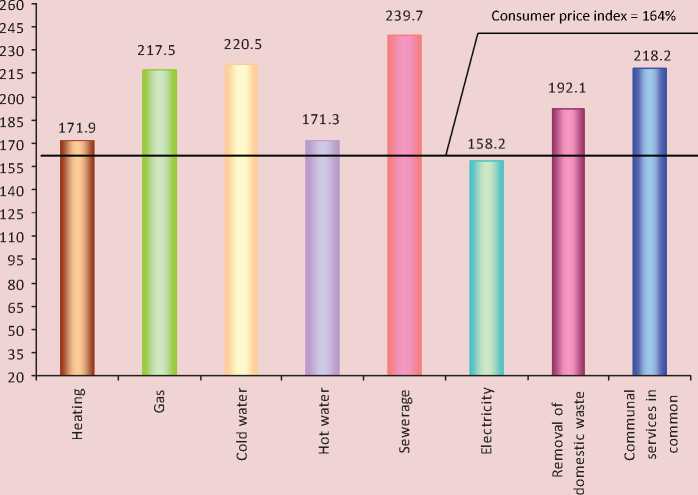
Table 4. The cost of public utilities for a standard apartment, area of 54 square meters and a family of three in month
Payment for capital repairs isn’t be charged in houses with a form of management HOA, HC, HBC , in some cases due to the fact that the house is new and it is not need of capital repair, or due to the fact that payment for repair is included in the fee for maintenance, for example – HOA “Dalnaya 18”. Growth of tariffs on payment for capital repairs in houses managed by private companies and municipalities for 2006 – 2010 years amounted to 332%, but this service is 4.4% in the structure
Table 5. Dynamics of tariffs for housing maintenance in the houses with various forms of management in Vologda (Jan. 1)
|
Management form |
2006 |
2007 |
2008 |
2009 |
2010 |
||||||
|
cost |
to 2005, % |
cost |
to 2006, % |
cost |
to 2007, % |
cost |
to 2008, % |
cost |
to 2009, % |
to 2006, % |
|
|
Municipal Management company |
10/17 |
No data |
10.17 |
100 |
12.0 |
118.0 |
14.16 |
118 |
14.16 |
100 |
139.2 |
|
“Fryazinovo” |
10.17 |
No data |
10.17 |
100 |
12.0 |
118.0 |
12.0 |
100 |
14.16 |
118 |
139.2 |
|
MC “Visis” |
10.17 |
No data |
10.17 |
100 |
12.0 |
118.0 |
12.0 |
100 |
14.50 |
120 |
142.6 |
|
MC “RES-12+” |
10.17 |
No data |
10.17 |
100 |
12.0 |
118.0 |
12.0 |
100 |
14.50 |
120 |
142.6 |
|
MC “RES-12” |
10.17 |
No data |
10.17 |
100 |
12.0 |
118.0 |
12.0 |
100 |
14.50 |
120 |
142.6 |
|
Housing and building company |
2.48 |
No data |
5.01 |
202.0 |
12.0 |
239.5 |
14.16 |
118 |
14.16 |
100 |
571 |
|
Homeowners association |
7.33 |
No data |
9.0 |
122.8 |
11.20 |
124.4 |
11.20 |
100 |
14.00 |
125 |
191 |
|
Housing cooperative |
9.77 |
No data |
9.77 |
100 |
9.77 |
100 |
9.77 |
100 |
9.77 |
100 |
100 |
|
Consumer price index, % |
109.0 |
111.9 |
113.3 |
108.8 |
108.8 |
164.0 |
|||||
Table 6. The dynamics of the tariffs on capital repairs in houses managed by private and municipal companies (January 1)
As a result, it can be concluded that the tariffs on communal services in the past five years have increased on average by 218% (an increase of consumer prices – 164%). The growth of tariffs is ahead the index of consumer price by 54%. Accordingly, it is reflected in the share of expenditure on public housing and communal services in the family budget, which annually increases (from 5.4% in 2000 to 10.2% in 2009; fig. 2 ).
According to a survey conducted by staff ISEDT RAS, in 2010, the average in the city proportion of pay for housing and communal services in the family budget was 20 – 30% (mentioned by about 63% of respondents). At the same time, about 13% of respondents to part with 40% of their family budgets to paying utility bills.
However, the situation in the housing and communal services in Vologda can be described as controversial. Despite the high growth rates of wages of employees of housing and communal services, as well as its excess in-kind over the average in the city wages of employees more than 40% (tab. 7) , the effectiveness of housing and utilities sector is still low.
This is evidenced by financial results of organizations providing housing services, which in 2007 and 2009 was negative (loss amounted to 20.6 and 73.3 million rubles, respectively; fig. 3 ).
In this regard, a significant increase in tariffs on housing services indicates the need for a clear understanding of the scheme of their formation. This is confirmed by the results obtained during the survey “Assessment of housing and communal services in Vologda”, conducted ISEDT RAS in 2010. The system of calculation of tariffs on housing services is
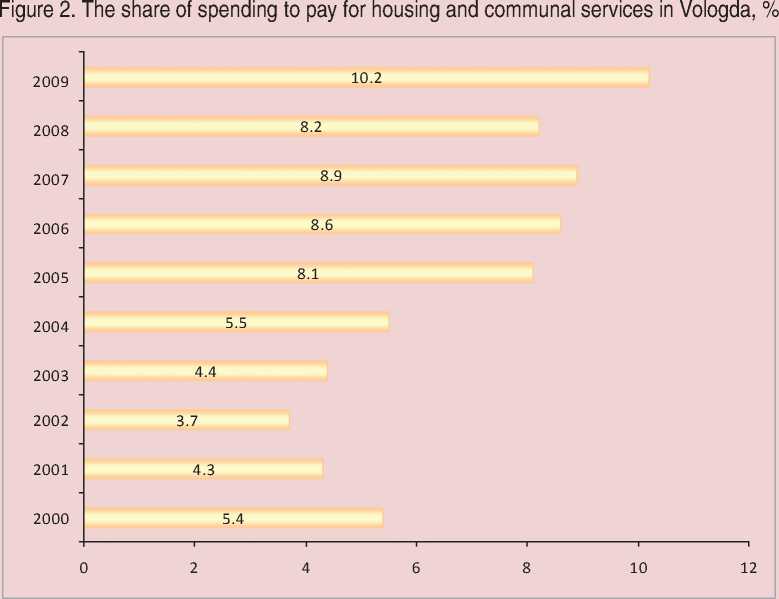
Table 7. Salaries of employees of organizations in Vologda, rub.
The survey data indicate a low awareness of population of Vologda in part of changes in the housing sector, as well as the problems of perception of diverse regulatory-legislative framework of tariff regulation in the housing sector, which consists of various legal acts of federal, regional and local importance.
The most important of them:
-
• Housing Code of the Russian Federation of 29.12.2004 № 188-FL;
-
• Federal Law of RF of 30.12.2004 № 210-FL “On the basis of tariff regulation organizations, public utilities”;
Figure 3. Financial result of activity of organizations of Housing and communal services in Vologda, mill. rub.
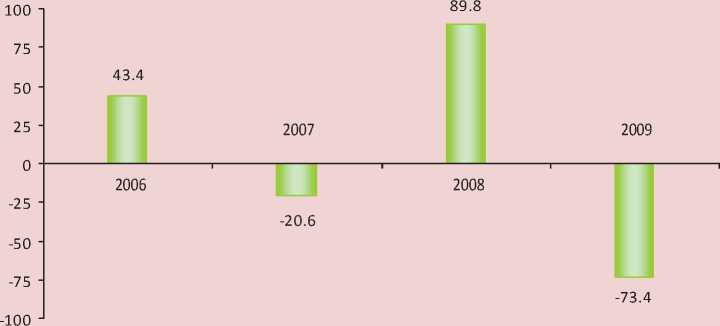
Source: Regions and cities of the Vologda oblast. Socio-economic indicators: stat. coll. / Vologdastat. – Vologda, 2010.
-
• Federal Law of 14.04.1995 № 41-FL “On state regulation of tariffs on electric and heating energy in the Russian Federation”;
-
• Government Resolution of 26.02.04 № 109 “On the pricing of electricity and heat in the Russian Federation”;
-
• Federal Law of 31.03.1999 № 69-FL “On Gas Supply in the Russian Federation”.
The Regional Energy Commission of the Vologda region is executive authority performing functions in the regulation of tariffs and markups on goods and services to the housing and communal sector, it provides:
-
■ tariffs (price, payment for the transfer) of electricity and heat supplied by all the supplying organizations;
-
■ prices for natural and liquefied gas sold to the population;
-
■ tariffs on goods and services organizations of public utilities (providing water and wastewater, wastewater treatment and disposal (burial) of municipal solid waste.
Tariffs for organizations engaged the production and transfer of heat and electri- city, are formed according to the scheme shown in figure 4.
The feature of the regulation of the tariffs is that the Federal Tariff Service sets the limits of tariff changes2 on the basis of forecast of socioeconomic development of the Russian Federation for the next year.
Pricing of services of gas supplying organizations differs from the previous scheme in that the Federal Tariff Service doesn’t set limits on tariff changes, but forms the wholesale price of the resource (fig. 5) .
The scheme of formation of tariffs on services of enterprises of communal complex providing cold and hot water supply, sewerage, sewage treatment and disposal (burial) of solid waste is presented in figure 6 . According to the existing powers public authorities establish tariffs based on the financial needs of these organizations necessary to implement production and investment programs.
Figure 4. Scheme of formation of tariffs on services of electricity and heat supplying
|
The Federal Tariff Service Sets limits on tariff changes:
|
|
|
The Regional Energetic Commission of the Vologda region Sets tariffs on:
|
|
|
Electric-heat supplying organization Apply tariffs set for end consumers |
|
Figure 5. Scheme of formation of tariffs on services of gas supplying organizations
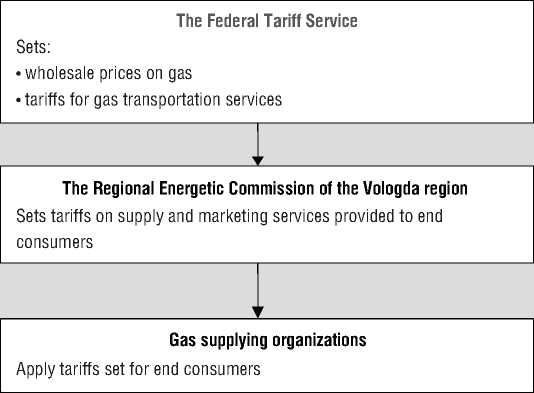
Formation of tariffs for housing services is different from the previous patterns of setting of tariffs on communal services that the payment for maintenance and repair of the dwelling is not regulated by the state, the order of its formation is not fixed by law. It is fixed at a general meeting of homeowners based on the estimates of ordered works and services, approved by the management company or homeowners’ asso- ciations. Planning of the cost of works is based on various resolutions issued by Gosstroi RF3 (The State Committee of Russian Federation for Construction).
Figure 6. Scheme of formation of tariffs on services of organizations providing: cold and hot water supply, sewerage, sewage treatment and disposal (burial) of solid waste
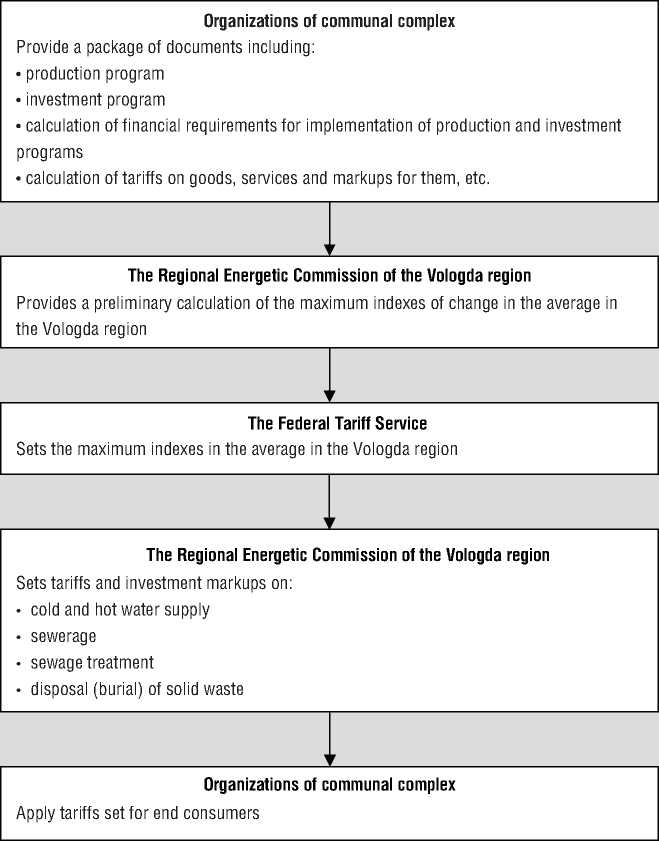
However, if owners of housing do not have decided on the form of housing management or with the magnitude of the tariff, the fee for the repair and maintenance of housing is set by local authorities.
In Vologda, it is established by the appropriate resolutions of the Head of Vologda [5]. This explains the difference in pay for housing services in homes with different forms of management.
Analysis of the existing schemes of tariffs on services of housing and communal organizations of the complex allows marking their following features:
-
1. Pricing of tariffs and markups on goods and services of energy-supplying organizations is based on the forecast of socio-economic development of the Russian Federation [7]. Such approach is economically unreasonable. In our opinion, in the sphere of regulation of natural monopolies pricing should be based on costs of production, excluding the possibility of economic profit at the expense of a monopoly position in the market.
-
2. The system of calculating of the maximum indices and tariffs by regulatory authori-
- ties and the absence of members of the public in this process allows characterizing this system as non- transparent.
-
3. A complex three-tier regulatory system allows realizing the interests of resource supplying organizations, making the approval process of tariffs politicized. The reason is that local authorities are also owners of the utilities’ property. This leads to the fact that relations between the enterprises of housing and communal services and local authorities became just administrative in nature.
-
4. The current regulatory system does not allow to take into account the payment actual incurred by the producer costs, the volume of real consumption and rate of loss of product during its production and delivery. This is a significant discrepancy between the amount of supply and consumption of the product (for example, the consumption of cold water in Vologda on the norm is 180 liters/day per person. On meter readings of the order of 73 liters/day per person; Hot water – 120 l liters/ day per person, actually consumed 55 liters/ day per person) [9].
-
5. Formation of tariffs for public services is not actually regulated by the state and depends on the activities of management companies.
These features of regulation of tariffs for housing and communal services explain the difference in the rate of its growth and in some way are the causes of its increase.
In order to determine the objectivity of the formation of tariffs for public utilities it is necessary to introduce a mandatory auditing expertise, conducted by a special commission consisting of representatives of the REC (The Regional Energetic Commission), and independent experts on housing and community representatives that allows:
-
• to identify inefficient and unreasonable costs included in the calculation of tariffs (various types of resources’ losses during transport to the end consumers);
-
• to take into account all factors that reduce cost of production at all levels of the pricing;
-
• to conduct an independent estimate of the usefulness and return on investment programs, after that a decision on their inclusion in the tariff structure should be made.
Administrations of Vologda and Cherepovets have already made first steps to regulate the activities of management companies. In Cherepovets the Public Council for Control of housing and communal services has been created, whose members together with the City intend to participate in the audit of the effectiveness of spending money by management companies.
In Vologda at the initiative of a group of deputies of the party “United Russia” the rating of management companies is formed, it takes into account the number of calls on the “hot line”, efficiency of problem solving, debt management companies to suppliers of public utilities, common area of residential buildings under management, and other indicators (tab. 8) . Then rating is higher, the more reliable is the company that provides utility services.
However, it should be noted that the population of Vologda is not adequately informed about the organizations that manage the housing stock. In our case only MC “Fryazinovo” and MC “Visis” have official internet sites with information in form of report about the providing of communal services in 2010. Houses on the streets of 77, Leningradskaya St. and 8, Goncharnaya St. are absent in the list of served houses on the official website of the Administration of Vologda.
In our view, in order to identify the objectivity of the formation of tariffs on housing and communal services is necessary:
о The Introduction of a mandatory auditing expertise, conducted by a special commission consisting of representatives of the Regional Energy Commission of the Vologda region, independent experts on housing and community representatives.
Table 8. Rating of management companies in Vologda (05.05.2011)
|
№ |
Name |
Number of houses |
Number of applications |
Solved applications |
Rate % |
|
1. |
Management company “CentrZhilStroy” |
6 |
20 |
20 |
89.8 |
|
2. |
MC “Teploservice” |
9 |
23 |
22 |
89.2 |
|
3. |
MC “Zhilstroyindustriya-service” |
13 |
6 |
3 |
88.9 |
|
4. |
MC “Vologdaagrostroy Service” |
14 |
15 |
9 |
88.6 |
|
5. |
MC “Vologda river port” |
1 |
1 |
0 |
88.5 |
|
6. |
MC “Vladistroycomfort” |
2 |
2 |
0 |
87.7 |
|
7. |
MC “Zhilkomhoz” |
9 |
6 |
0 |
86.8 |
|
8. |
MC “Roszhilkom” |
3 |
3 |
2 |
86.0 |
|
9. |
MC “Santehmontazh 1” |
3 |
0 |
0 |
81.0 |
|
10. |
MC “House manager” |
8 |
0 |
0 |
81.0 |
|
……… |
|||||
|
16. |
MC “Visis” |
7 |
5 |
3 |
80.1 |
|
17. |
MC “New technologies” |
29 |
55 |
48 |
79.9 |
|
……… |
|||||
|
33. |
Municipal autonomous organization “Housing Authority of Vologda” |
1281 |
782 |
734 |
71.9 |
|
34. |
MC “Res-3” |
78 |
175 |
145 |
71.7 |
|
……… |
|||||
|
39 |
MC “Fryazinovo” |
120 |
190 |
182 |
71.3 |
|
……… |
|||||
|
42. |
MC “Res-12+” |
35 |
81 |
71 |
71.1 |
|
……… |
|||||
|
45. |
MC “Res-12” |
78 |
174 |
138 |
70.7 |
|
……… |
|||||
|
47. |
MC “House-Service-3” |
20 |
32 |
12 |
19.3 |
* Official site of the city of the Administration of Vologda. – Available at:
Conducting of audit expertise may be at least 1 time per year (based on the REC of the Vologda region) with the obligatory publication of the results in the media (newspaper “Red North”, “Vologda week”, etc.).
о The activities of management companies in Vologda should be more transparent and open, so reporting on the results of their work should be available to the public. Annual reports of asset management companies should be available to owners of housing stock. In this context, guided by the resolution Government of RF dated September 23, 2010 № 731, to oblige the management companies to publish reports on its activities on their websites or on the site of the local government of the municipality. And they should be available within 5 years.
о Increased awareness of population of Vologda on legislative changes in the housing and communal services. It is necessary for local authorities and management companies to conduct systematic work on public awareness on the reform of housing and utilities, on changes in the legal acts related to housing and community services, both at the level of municipality and region, and the Russian Federation a whole.
The introduction of such measures in housing management practice will bring clarity to the decision of many controversial issues, and will also help to keep the growth of tariffs for public utilities that provide protection of the economic interests of the public and other consumers.
Список литературы Analysis of tariff regulation in housing and utilities economy (in case of the city of Vologda)
- Housing Code of the Russian Federation of 29.12.2004 № 188-FL.
- On Gas Supply in the Russian Federation: Federal Law of 31.03.1999 № 69-FL.
- On state regulation of tariffs on electric and heating energy in the Russian Federation: Federal Law of 14.04.1995 № 41-FL.
- On the basis of tariff regulation organizations, public utilities: Federal Law of RF of 30.12.2004 № 210-FL.
- On establishing fees for maintenance and repair of the dwelling for residential tenants on social contracts of employment and contracts of employment premises of community housing: Resolution of the Head of Vologda on 10.04.2009 № 1854 (as amended on 29.12.2010).
- On approval of rules maintenance of common property in multi-apartment building and the rules change the size of fees for maintenance and repair of the dwelling in case of service delivery and performance of work on management, maintenance and repair of common property in apartment buildings of inadequate quality and (or) at intervals greater than set duration: RF Government Resolution 13.08.2006 № 491.
- On the pricing of electricity and heat in the Russian Federation: Government Resolution of 26.02.04 № 109.
- Afonina, A.V. About Protection of right of Consumers of utility services/A.V. Afonina//Journal of the head and chief accountant. -2008. -№ 4. -Pp. 56-61.
- Proposals to improve the efficiency of resource use in the sphere of houses water supply: Report on Research and Development/A.S. Barabanov, A.N. Nesterov. -Vologda, 2010. -98 p.
- Civil Society and housing and communal services: materials of report of the Public Chamber RF from April 6, 2011.
- Economics and Organization of Housing and communal services of the city: textbook for university students/ed. by D.M Zhukov. -M.: VLADOS-PRESS, 2003. -216 p.
- Kamenev, E.A. Finance of Housing and communal services/E.A. Kamenev, S.V. Barulin. -M.: Axis-89, 2003. -312 p.
- Klyuyeva, O.N. On limiting growth rates indices for 2010/O.N. Klyueva//Rates and investment. -2009. -№ 4. -Pp. 46-47.
- Ognev, I.A. Reform of Housing and communal services in a deadlock/I.A. Ognev//ECO. -2010. -№ 3. -Pp. 92-107.
- Chernyshov, L.N. Pricing and tariff policy in housing and communal services/L.N. Chernyshov: ed. by E.V. Basin. -M.: Book World, 2005. -183 p.

